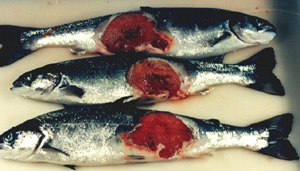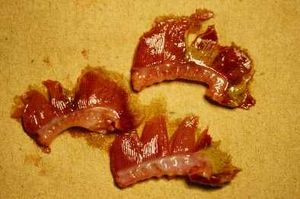Flexibacter
A Microbial Biorealm page on the genus Flexibacter

Classification
Higher order taxa:
Bacteria; Bacteroidetes/Chlorobi group; Bacteroidetes; Sphingobacteria; Sphingobacteriales; Flexibacteraceae
Species:
Flexibacter aggregans; F. echinicida; F. elegans; F. filiformis; F. flexilis; F. japonensis; F. litoralis; F. polymorphus; F. roseolus; F. ruber; F. sancti; F. cf. sancti; F. tractuosus; Flexibacter sp.
|
NCBI: Taxonomy Genome |
Description and Significance
Flexibacter is well known for its yellow-hued species that are identified as fish pathogen which can affect the gills, skin, eggs, and larvae of a variety of fish species (Crump). Flexibacter has also been isolated from soil environments.Soil Flexibacters such as Flexibacter canadensis denitrifies NO3 and NO2 to gaseous forms with tolerances to oxygen. Denitrification is membrane bound.
Genome Structure
Currently there are no known projects in progress or planned for the near future to further examine Flexibacter by sequencing a genome. However, there is always hope for future development in this process to gain better insight about the structure of Flexibacter. In addition, DNA sequencing of many species of Flexibacter has occured, yielding valuable information. To learn more about the DNA sequencing of Flexibacter results, click here.
Cell Structure and Metabolism
Flexibacter is a chemoorganotrophic, Gram-negative bacteria that traditionally grows in a rod-shaped cell format. Cell length ranges from between 0.5 by 5 to 100 um. Flexibacter cells are also known for being very flexible in cell structure. Though they are not flagellated, Flexibacter cells are motile by means of gliding (Eddleman).
Ecology

Traditionally found in marine habitats, Flexibacter has been described as an organism of flexibility in terms of habitat choice. Flexibacter has been isolated from a variety of aqueous conditions including some that range both between oxic and anoxic as well as between sulphide and acidic (Astrobiology).
Pathology


Flexibacter is a known fish pathogen which causes gill disease, as well as egg and larvae disease, which raises the death rates of certain fish species, such as Koi, once infected (KOISTAFF). One strain of the disease which causes illness in halibut eggs and larvae is cause by Flexibacter ovolyticus (Hansen). Infections most often occur when the quality of the water is poor and raised in temperature. One of the most common gill diseases is cause by Flexibacer branchiophila. This causes a hyperplasia that grows in the epithelium of the gill lamellae, also causing hypertrophy early in the disease which later leads to the development from the normal flat epithelial cells to cuboidal or columnar cells and oval chloride cells. The epithelium continues to proliferate, eventually leading to the clubbing and fusing of the gill lamellae. Evidence also has been found suggesting additional damage created by bacterial cells adhering to the outermost epithelial layer (Bullock).
References
[http://microscope.mbl.edu/scripts/microscope.php?func=imgDetail�!ID=352 Astrobiology Institute, The. Marine Biological Laboratory. Information About Microbes. "Flexibacter."]
Eddleman, H. "A Short Guide to Some Bacteria Genera." 18 Feb 1997. Indiana Biolab.
KOISTAFF. Koi Clinic. "Koi and Goldfish disease Information." 4 June 2000.
